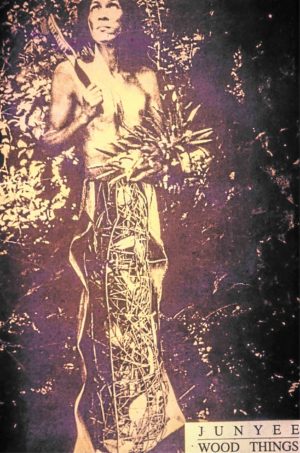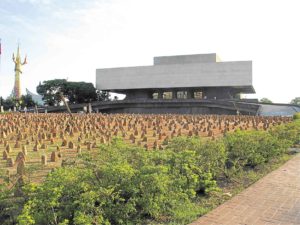
Seminal” is a word often overused to describe artists who are merely influential.
In Junyee’s case, no other word will do, for he is a true progenitor.
In 1970, in the heady aftermath of the First Quarter Storm when, as Bob Dylan sang, “There was music in the cafés at night and revolution in the air,” Junyee began his own quiet revolt sui generis.
Within the campus of the University of the Philippines Diliman, where he had studied sculpture, apprenticed with future National Artist Napoleon Abueva, and been drawn into the progressive movement, Junyee constructed a framework of bamboo strips, roughly hewn with a gulok, the peasant’s all-purpose machete, and bound together with rope. From this were hung poems, protest slogans, fruits and other objects by students.
It was an expression of the Filipino spirit of bayanihan, an act of communalism in what the activists of the day, the artist included, fancied as a “liberated zone.”
Junyee called his work “Balag,” the Visayan word for “trellis.”
“It was my first open-air one-man show,” he recalls. “For the first time, there was an artwork that was not intended for sale. It was ephemeral. There was participation from the audience. I used indigenous materials, Filipino culture, bayanihan. And that was in 1970. There was no ‘contemporary’ art then, we were still in the ‘modern’ period.”
From where did he draw his inspiration?
“I just wanted to do it,” he says.

Energy currents
It was only nine years later that the critic Ray Albano told him that what he had created was an “installation,” a term that was only beginning to gain currency in the 1970s.
By that time, Junyee had refined his conception and made others, without having a name for what he was doing or worrying too much about it. He was, he felt, merely channeling energy currents from the cosmos and letting them guide his hands.
“I was born an artist,” he says. “I had nothing to do with it. It’s my nature. As far as I’m concerned, making art is not a livelihood. It’s something that you cannot refuse, you cannot stop. I have no choice. I have to do my thing.”
“Malabayabas at iba pang kahoy natin,” tall stacks of hardwood that were installed at the Luneta in 1976; “Abortion,” a large egg-like structure of vines and leaves in 1979 at the Cultural Center of the Philippines (CCP); and “Wood Things,” an entire alien environment in 1980, also at the CCP, were unlike anything that had been seen before in the local art scene.
“It was the tendency of the time,” he says. “Artists felt they had exhausted all the possibilities and the only way forward is to go back to material. It was in the air. I was not aware that there was installation art in other countries. I wasn’t influenced by other artists here or abroad. I always used our culture, my being Filipino, as an inspiration.”
The template that Junyee established—the creation of an interactive space, the use of organic indigenous materials, the incorporation of performance and ritual—has been hugely influential on the work of younger artists such as Santiago Bose and Robert Villanueva, to name just two. Installation is also now a recognized genre of contemporary Philippine art with many practitioners. But Junyee remains a true “orig,” still on his own trip.
Under the radar
We are in a corner of the CCP Main Theater where “Wood Things,” the first book-length published appraisal of the 75-year-old artist’s life and work, is being launched. It is a rare public moment for an artist who has operated largely under the radar.
“I am the least publicized artist in the country,” he says. By his own count, Junyee has only had four one-man shows in commercial galleries since “Balag,” despite winning numerous prizes both here and abroad.
Although he also does free-standing sculptures and paintings, Junyee’s major works have been installations that have a finite lifespan. After their brief existence, they exist only in documentation, and in fact, many of his earlier works, “Balag” included, were never documented.
The ephemerality of much of his art has never been a concern.
“I really don’t care if my works are preserved,” he says. “It’s the act of creating that’s important to me. I have to prove it to myself and to somebody up there, whatever the source of my talents is.”
Junyee considers his art a spiritual journey.
“Installation gave me the freedom to approach the point of total creation,” he says. “In ‘Wood Things,’ for instance, I created a totally alien environment, complete in itself, and that is the nearest I can get to the essence of creation.”
Beyond that, he adds, is God’s domain.

Milestone
Be that as it may, “Wood Things” the book is an important milestone, giving the artist long-overdue recognition and, more importantly, chronicling his artistic journey thus far.
Like many of Junyee’s projects, the book was years in gestation, having been conceived nearly a decade ago. Fortunately, the artist found kindred spirits in publisher Hugo “Boboy” Yonzon III and author Jose “Bogie” Tence Ruiz to bring the project to fruition after a publication grant from the National Commission on Culture and the Arts was obtained.
Tence Ruiz makes for the ideal Boswell. Being himself an installation artist of some note (his work “Shoal” was one of the Philippines’ entries in the last Venice Biennale), he offers a unique insight into Junyee’s creative process as well as a keen appreciation of his milieu.
“I wanted to get at the myth, because that’s how I first came to know Junyee—the guy who burned everything he had,” says Tence Ruiz.
“I had the feeling that nobody paid enough attention to his story to put it all together, like Nonoy Marcelo,” he adds, speaking of another artist from Junyee’s time who hasn’t gotten the respect he deserves.
“I compare [Junyee] to Paul Ricca, the master gangster that nobody ever knew,” says Tence Ruiz, referring to the mobster who controlled the Chicago rackets for four decades. “Everybody knows Al Capone, but why was Ricca never known? Because he was a master gangster. He doesn’t get known.”
Odd jobs
The man who would be Junyee was born Luis Enano Yee Jr. in 1942 in Agusan del Norte, the son of a Chinese immigrant father and a Filipina mother who hailed from a landed family in Surigao. From an early age he was creative, teaching himself to draw by copying from comic books and illustrated magazines, modeling figures from clay and candlewax, and making his own toys from scraps of wood.
After taking an elective visual arts subject in high school, Junyee began to nurture dreams of one day becoming a “real” artist, but his father, who had built up a string of businesses from scratch, was dead set against it. Instead he was put to work in a variety of odd jobs to learn what “real life” was like, helping to manage a seedy hotel, and in a peculiarly macabre turn, working as a mortuary assistant in a funeral parlor in Cebu.
The family experienced a dramatic reversal of fortune following Yee Sr.’s sudden death, and Junyee put his artistic dreams on hold to help support his mother and siblings. He was already 22 when, after the family’s finances were stabilized, he was finally able to enroll as a scholar at the College of Fine Arts in UP Diliman.
In 1964, he found himself under the wing of one of his teachers, the renowned sculptor Napoleon Abueva. Recognizing his student’s obvious talents, Abueva took him in as an apprentice. By the late 1960s, Junyee was eking out a bare bohemian existence as a struggling artist in a rented room in Krus na Ligas.
Filipino-ness
Caught up in the spirit of the times, Junyee joined the Left-wing Brotherhood of the Plebeians, a precursor to the more radical activist groups that emerged in the 1970s. He also became the art editor of the Philippine Collegian.
By this time, Junyee was squarely in the social realist camp, creating paintings and sculptures that dripped with political commentary against fascism, imperialism and neocolonialism. But he was also open-minded enough to be receptive to other streams of the cultural revolt that valued inner exploration over social action. He was particularly influenced by the writings of Carlos Castañeda on shamanism and the psychedelic experience.
“It was the combination of several forces that were taking shape in my mind and my being: activism, the question of what is Philippine art, the environment. Even though I’m half-Chinese, I’m very Filipino. I was offered a job to work for Walt Disney in the States, but I refused. I’ve never left this country. It never entered my mind that I should use my talents in sculpture to become famous, to make money. I was searching for an expression through which I could reveal my soul, my being, my Filipino-ness.”
He found it in “Balag.”
Mythical moment
Shortly after came the mythical moment that Tence Ruiz describes in the book as a “reboot.”
Gathering all his worldly possessions together, save for a knapsack, three pairs of jeans and an assortment of sculptor’s tools, Junyee poured kerosene over them and set them on fire.
“I decided to risk everything and start with a clean slate,” Junyee recalls. “That’s why I could burn all of my possessions. I detached myself from all the hindrances of the modern world so that I could do what I wanted to do.”
He was 29 at the time. Junyee would spend the next 45 years at the foot of Mt. Makiling in Los Baños, Laguna, refining his vision, emerging every few years or so to report on his progress with a landmark installation work, a journey that is retrospectively mapped in “Wood Things.”
The relative isolation of the Makiling forest gave Junyee the time and space he needed to incubate his art and nurture it to maturity.
It was also in Los Baños that he would meet an animal husbandry student named Tess Gatchalian, the woman that he would woo and eventually marry in 1984.
“I’m a happy guy, a jolly guy, a friendly guy,” he says. “As long as I have enough to express myself, I’m satisfied. What I’m not satisfied with is what I have done.”
Apart from installations, Junyee now accepts commissions for public art, something that he used to avoid as an unnecessary distraction from his work. He has also gained acclaim for his soot paintings, using the flame from a hand-held glass lamp to “paint” images on a board.
He is currently working on what could eventually be the largest installation in Asia, putting up markers for 33 martyrs from Batanes to Sulu.
“I always experiment,” he says. “It’s the only way you can find out things. I’ve never lost the fascination to explore the world, to explore the area of art-making. In fact, I am more curious now than when I was younger, maybe because I have a certain maturity now.”
He hints that, perhaps, he is ready to move beyond installation art.
“I am looking forward to doing something much bigger than installation, in a sense,” he says. “I have some idea of how to approach it, but it’s my habit not to show something before it has matured.”
“Balag,” a musical based on the life and art of Junyee, will be staged at the NCAS Auditorium at UP Los Baños, Nov. 7-9, 7 p.m.









































